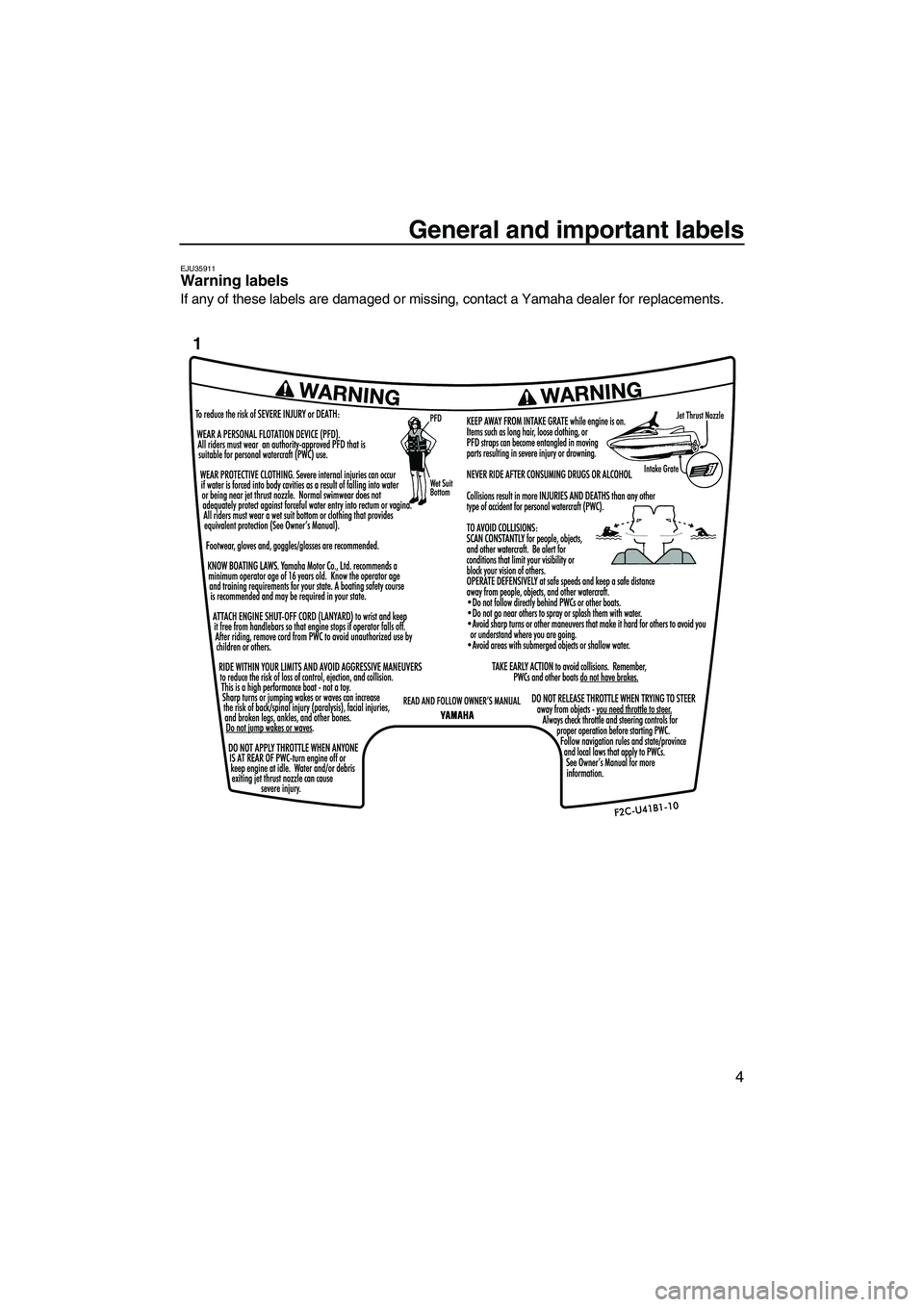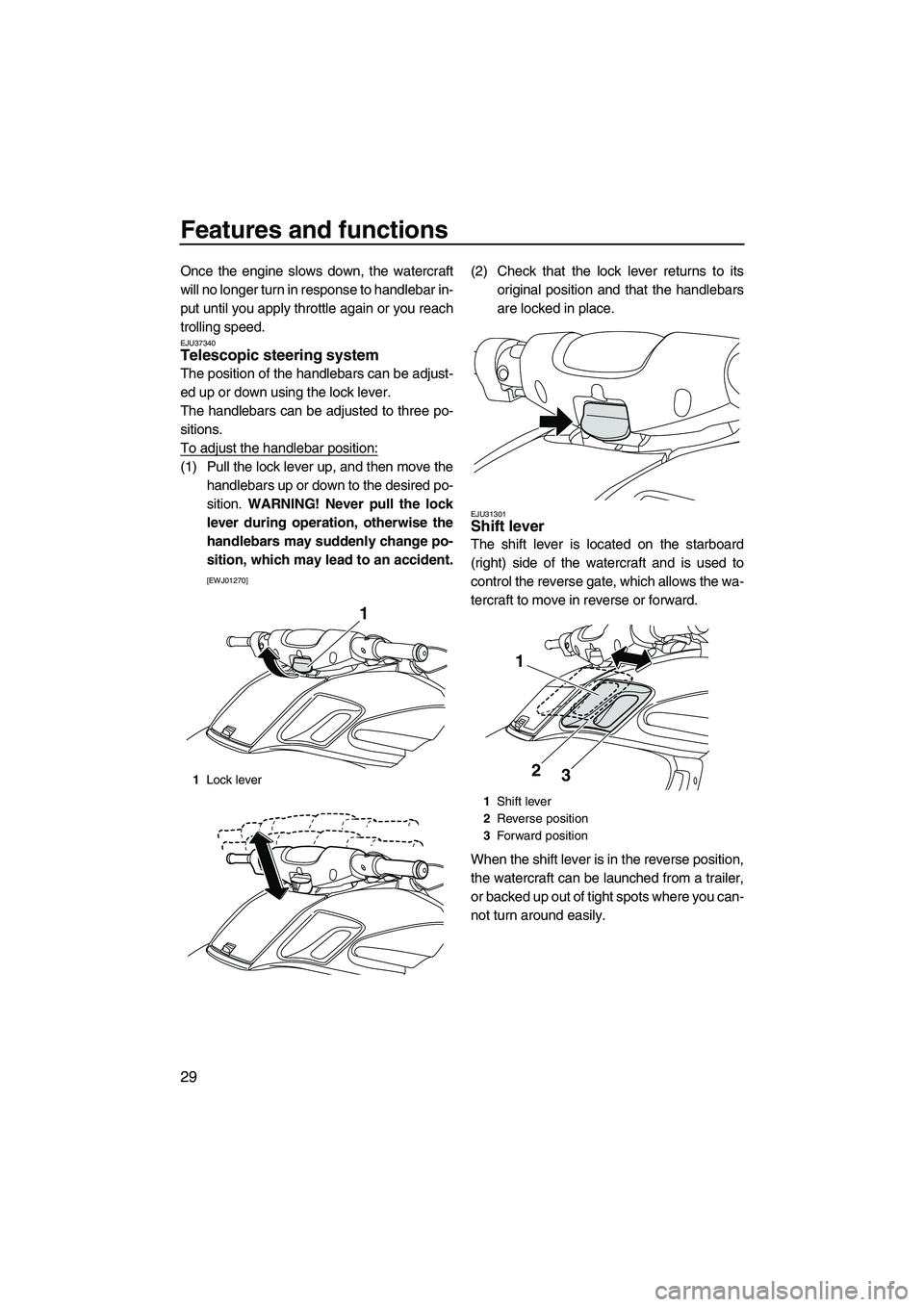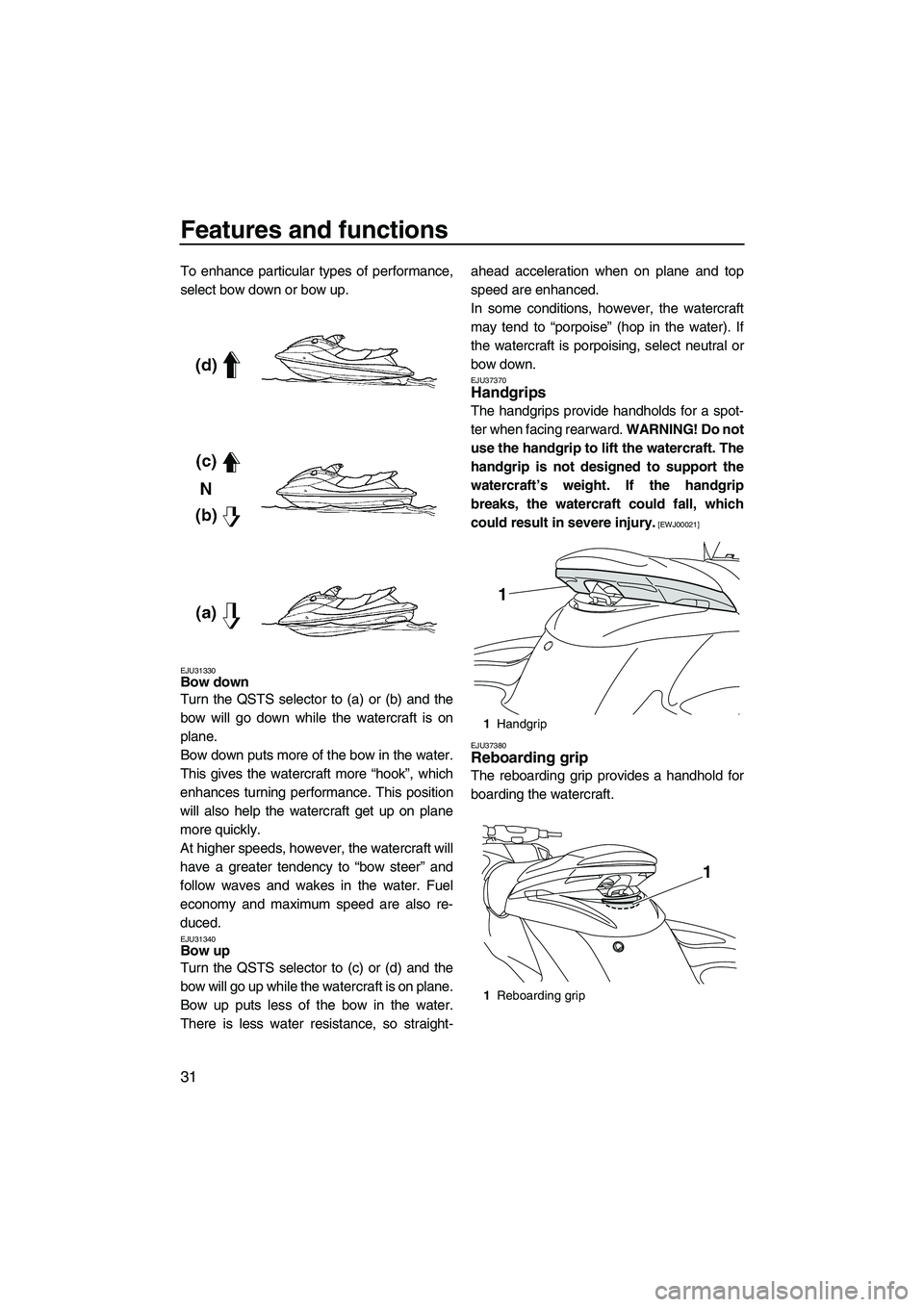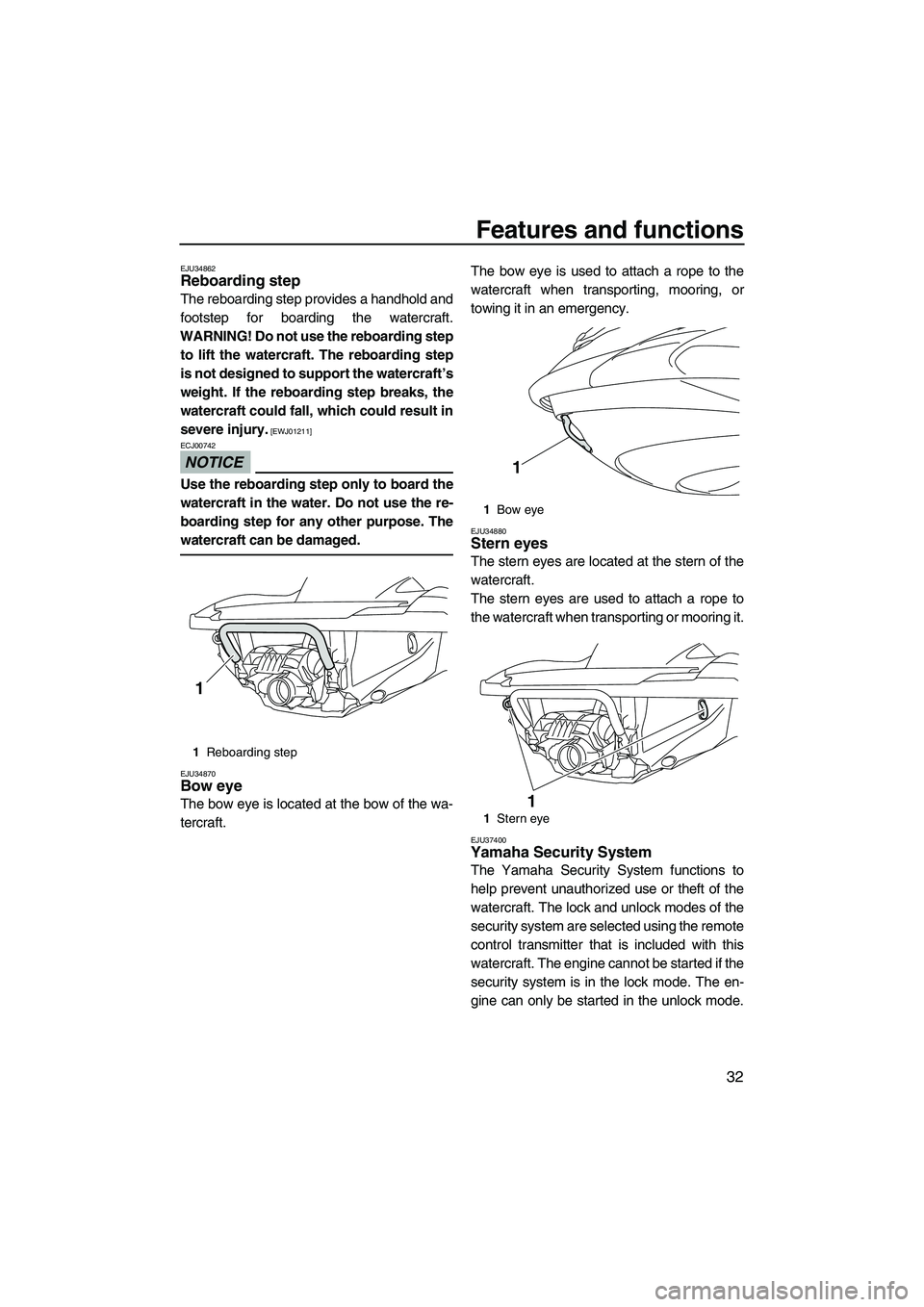2009 YAMAHA FZS warning
[x] Cancel search: warningPage 5 of 98

Important manual information
EJU30191
To the owner/operator
Thank you for choosing a Yamaha watercraft.
This owner’s/operator’s manual contains in-
formation you will need for proper operation,
maintenance, and care. If you have any ques-
tions about the operation or maintenance of
your watercraft, please consult a Yamaha
dealer.
This manual is not a course on boating safety
or seamanship. If this is your first watercraft,
or if you are changing to a type of watercraft
you are not familiar with, for your own comfort
and safety, please ensure that you obtain
proper training or practice before operating
the watercraft by yourself. In addition, a
Yamaha dealer or boating organization will be
pleased to recommend local sea schools, or
competent instructors.
Because Yamaha has a policy of continuing
product improvement, this product may not be
exactly as described in this owner’s/opera-
tor’s manual. Specifications are subject to
change without notice.
This manual should be considered a perma-
nent part of this watercraft and should remain
with it even if the watercraft is subsequently
sold.
In this manual, information of particular impor-
tance is distinguished in the following ways:
The Safety Alert Symbol means ATTEN-
TION! BECOME ALERT! YOUR SAFETY IS
INVOLVED!
WARNING
EWJ00071
A WARNING indicates a hazardous situa-
tion which, if not avoided, could result in
death or serious injury.
NOTICE
ECJ00091
A NOTICE indicates special precautions
that must be taken to avoid damage to the
watercraft or other property.
TIP:
A TIP provides key information to make pro-
cedures easier or clearer.
EJU30231
WaveRunner FZS
OWNER’S/OPERATOR’S MANUAL
©2008 by Yamaha Motor Co., Ltd.
1st Edition, October 2008
All rights reserved.
Any reprinting or unauthorized use
without the written permission of
Yamaha Motor Co., Ltd.
is expressly prohibited.
Printed in U.S.A.
UF2C70E0.book Page 3 Monday, November 3, 2008 10:16 AM
Page 6 of 98

Table of contents
General and important labels ........... 1
Identification numbers .................... 1
Primary Identification (PRI-ID)
number ........................................... 1
Craft Identification Number (CIN) ...... 1
Engine serial number ........................ 1
Model information ........................... 2
Builder’s plate .................................... 2
Important labels .............................. 3
Warning labels ................................... 4
Other labels ....................................... 8
Safety information ........................... 10
Limitations on who may operate
the watercraft ............................ 10
Cruising limitations ....................... 11
Operation requirements ............... 12
Recommended equipment ........... 14
Hazard information ....................... 15
Watercraft characteristics ............. 15
Water-skiing ................................. 17
Safe boating rules ........................ 18
Enjoy your watercraft
responsibly ................................ 19
Features and functions ................... 20
Location of main components ...... 20
Operation of controls and other
functions .................................... 24
Seats ............................................... 24
Hood ................................................ 25
Fuel tank filler cap ........................... 25
Remote control transmitter .............. 25
Engine stop switch .......................... 26
Engine shut-off switch ..................... 26
Start switch ...................................... 27
Throttle lever ................................... 27
Cooling water pilot outlets ............... 28
Steering system ............................... 28
Telescopic steering system ............. 29
Shift lever ........................................ 29
Quick Shift Trim System (QSTS)
selector ........................................ 30Handgrips ........................................ 31
Reboarding grip ............................... 31
Reboarding step .............................. 32
Bow eye ........................................... 32
Stern eyes ....................................... 32
Yamaha Security System ................ 32
Dual analog meter unit .................... 35
Storage compartments .................... 39
Operation ......................................... 43
Fuel and oil .................................. 43
Fuel ................................................. 43
Engine oil ......................................... 44
Pre-operation checks ................... 45
Pre-operation check list ................... 45
Pre-operation check points .............. 47
Operation ..................................... 55
Engine break-in ............................... 55
Launching the watercraft ................. 55
Starting the engine .......................... 55
Stopping the engine ........................ 56
Shifting ............................................ 57
Leaving the watercraft ..................... 57
Operating your watercraft ............ 58
Getting to know your watercraft ....... 58
Learning to operate your
watercraft ..................................... 58
Riding with passengers ................... 59
Starting the watercraft ..................... 59
Boarding and starting in deep
water ............................................ 60
Capsized watercraft ......................... 63
Turning the watercraft ..................... 64
Stopping the watercraft ................... 65
Beaching the watercraft ................... 66
Docking the watercraft ..................... 66
Reverse on waterways .................... 66
Operating in weeded areas ............. 67
Post-operation care ...................... 67
Transporting ................................. 68
Maintenance and care .................... 69
Storage ........................................ 69
Flushing the cooling system ............ 69
UF2C70E0.book Page 1 Monday, November 3, 2008 10:16 AM
Page 11 of 98

General and important labels
4
EJU35911Warning labels
If any of these labels are damaged or missing, contact a Yamaha dealer for replacements.
1
UF2C70E0.book Page 4 Monday, November 3, 2008 10:16 AM
Page 36 of 98

Features and functions
29
Once the engine slows down, the watercraft
will no longer turn in response to handlebar in-
put until you apply throttle again or you reach
trolling speed.
EJU37340Telescopic steering system
The position of the handlebars can be adjust-
ed up or down using the lock lever.
The handlebars can be adjusted to three po-
sitions.
To adjust the handlebar position:
(1) Pull the lock lever up, and then move the
handlebars up or down to the desired po-
sition. WARNING! Never pull the lock
lever during operation, otherwise the
handlebars may suddenly change po-
sition, which may lead to an accident.
[EWJ01270]
(2) Check that the lock lever returns to its
original position and that the handlebars
are locked in place.
EJU31301Shift lever
The shift lever is located on the starboard
(right) side of the watercraft and is used to
control the reverse gate, which allows the wa-
tercraft to move in reverse or forward.
When the shift lever is in the reverse position,
the watercraft can be launched from a trailer,
or backed up out of tight spots where you can-
not turn around easily.
1Lock lever
1
1Shift lever
2Reverse position
3Forward position
3 2 1
UF2C70E0.book Page 29 Monday, November 3, 2008 10:16 AM
Page 38 of 98

Features and functions
31
To enhance particular types of performance,
select bow down or bow up.
EJU31330Bow down
Turn the QSTS selector to (a) or (b) and the
bow will go down while the watercraft is on
plane.
Bow down puts more of the bow in the water.
This gives the watercraft more “hook”, which
enhances turning performance. This position
will also help the watercraft get up on plane
more quickly.
At higher speeds, however, the watercraft will
have a greater tendency to “bow steer” and
follow waves and wakes in the water. Fuel
economy and maximum speed are also re-
duced.
EJU31340Bow up
Turn the QSTS selector to (c) or (d) and the
bow will go up while the watercraft is on plane.
Bow up puts less of the bow in the water.
There is less water resistance, so straight-ahead acceleration when on plane and top
speed are enhanced.
In some conditions, however, the watercraft
may tend to “porpoise” (hop in the water). If
the watercraft is porpoising, select neutral or
bow down.
EJU37370Handgrips
The handgrips provide handholds for a spot-
ter when facing rearward. WARNING! Do not
use the handgrip to lift the watercraft. The
handgrip is not designed to support the
watercraft’s weight. If the handgrip
breaks, the watercraft could fall, which
could result in severe injury.
[EWJ00021]
EJU37380
Reboarding grip
The reboarding grip provides a handhold for
boarding the watercraft.
1Handgrip
1Reboarding grip
1
1
UF2C70E0.book Page 31 Monday, November 3, 2008 10:16 AM
Page 39 of 98

Features and functions
32
EJU34862Reboarding step
The reboarding step provides a handhold and
footstep for boarding the watercraft.
WARNING! Do not use the reboarding step
to lift the watercraft. The reboarding step
is not designed to support the watercraft’s
weight. If the reboarding step breaks, the
watercraft could fall, which could result in
severe injury.
[EWJ01211]
NOTICE
ECJ00742
Use the reboarding step only to board the
watercraft in the water. Do not use the re-
boarding step for any other purpose. The
watercraft can be damaged.
EJU34870Bow eye
The bow eye is located at the bow of the wa-
tercraft.The bow eye is used to attach a rope to the
watercraft when transporting, mooring, or
towing it in an emergency.
EJU34880Stern eyes
The stern eyes are located at the stern of the
watercraft.
The stern eyes are used to attach a rope to
the watercraft when transporting or mooring it.
EJU37400Yamaha Security System
The Yamaha Security System functions to
help prevent unauthorized use or theft of the
watercraft. The lock and unlock modes of the
security system are selected using the remote
control transmitter that is included with this
watercraft. The engine cannot be started if the
security system is in the lock mode. The en-
gine can only be started in the unlock mode.
1Reboarding step
1
1Bow eye
1Stern eye
1
1
UF2C70E0.book Page 32 Monday, November 3, 2008 10:16 AM
Page 42 of 98

Features and functions
35
EJU37431Dual analog meter unit
The dual analog meter unit displays various
watercraft information.
Dual analog meter unit initial operation
When the dual analog meter unit starts oper-
ating, the speedometer and tachometer make
one sweep, all segments of the information
display and all indicator lights come on. After
2 seconds, the “WARNING” indicator light, the
“L-MODE” indicator light, and the warning in-
dicators in the information display go off, and
then the unit starts to operate normally.
TIP:
The “UNLOCK” indicator light will go off when
the engine is started.
Dual analog meter unit standby state
If the dual analog meter unit does not receive
any operation input within 25 seconds after
the engine stops, the unit will turn off and en-
ter a standby state. When the engine is start-
ed again, the display and the indicator lights
will return to their state before the unit turned
off, and then the unit starts to operate normal-
ly.
EJU37440Speedometer
The speedometer shows the watercraft speed
against water.
The large inner numbers on the meter show
the watercraft speed in miles per hour “MPH”
and the small outer numbers show the speed
in kilometers per hour “km/h”.
EJU37240Tachometer
The tachometer shows the engine speed.
The large inner numbers on the meter show
the engine speed × 1000 RPM (r/min).
1Speedometer
2Information display
3Tachometer
4“Hour Volt” button
5“UNLOCK” indicator light
6“L-MODE” indicator light
7“WARNING” indicator light
123
7 6 5 4
UF2C70E0.book Page 35 Monday, November 3, 2008 10:16 AM
Page 43 of 98

Features and functions
36
EJU37250Information display
The information display shows watercraft op-
erating conditions.
EJU37261Hour meter/voltmeter
The hour meter/voltmeter can be used as an
hour meter or a voltmeter.
TIP:
The hour meter is selected at the Yamaha
factory.
Hour meter
The hour meter shows the hours of engine op-
eration that have elapsed since the watercraft
was new.To switch to the hour meter from the voltme-
ter:
Push the “Hour Volt” button for at least 1 sec-
ond. The display switches from the voltmeter
to the hour meter.
Voltmeter
The voltmeter shows the battery voltage.
When the battery voltage is normal, the volt-
meter displays approximately 12 volts.
If the battery voltage has dropped significant-
ly, “LO” is displayed on the voltmeter. If the
battery voltage has risen significantly, “HI” is
displayed. If “HI” or “LO” is displayed, immedi-
ately return to shore and have a Yamaha
dealer service the watercraft.
1Fuel level meter
2Fuel indicator
3Engine overheat warning indicator
4Check engine warning indicator
5Oil pressure warning indicator
6Hour meter/voltmeter
1Hour meter/voltmeter
12345
6
1
1“Hour Volt” button
2Hour meter
1
2
UF2C70E0.book Page 36 Monday, November 3, 2008 10:16 AM